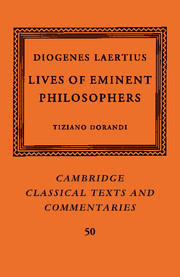INTRODUCTION
Published online by Cambridge University Press: 05 May 2013
Summary
The Lives and Opinions of Eminent Philosophers by Diogenes Laertius (third century AD) are transmitted (entirely, partially, or in the form of excerpts) by a hundred or so manuscripts. The oldest witnesses of this tradition are three continuous manuscripts (B, P and F), datable between the end of the eleventh century and the thirteenth century, and three collections of excerpts, two (Φ/Φh) copied in a Vatican MS of the twelfth century (and in its descendants) and the third in a MS in Vienna (Vi) written and dated 28 July 925. All other manuscripts date from the fourteenth to the sixteenth centuries, though some manuscripts with excerpts are as late as the eighteenth.
P Paris, Bibliothèque nationale de France, gr. 1759. 11th/12th cent. Oriental paper. 210×150 mm. ff. I + 251 (ff. 174r end, 174v–176r blanks). Written at Constantinople by two contemporary anonymous hands (A: 1r–95r; B: 95v–251v). There is evidence of six correctors (P2–7), the most important of whom is indicated with the siglum P4. In f. Ar, a later hand (15th–16th cent.) copied an epitaph on Emperor Basil II the Bulgar–slayer ‘Bulgaroktonos’ (958–1025), followed by two further epitaphs, one on Julian the Apostate and one on a certain Bessarion. In f.
- Type
- Chapter
- Information
- Diogenes Laertius: Lives of Eminent Philosophers , pp. 1 - 58Publisher: Cambridge University PressPrint publication year: 2013

